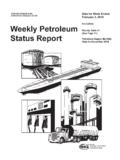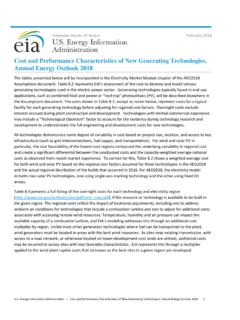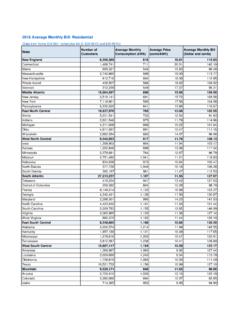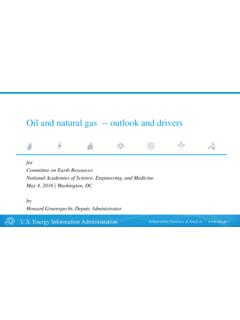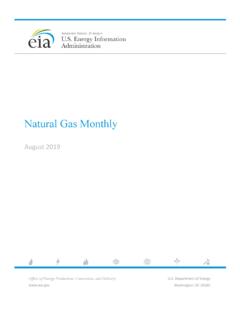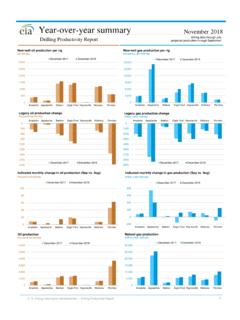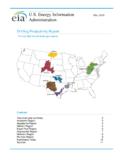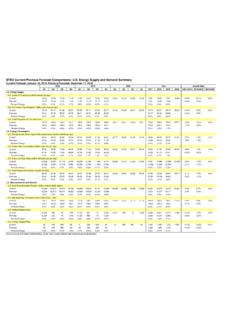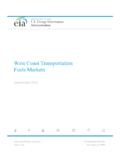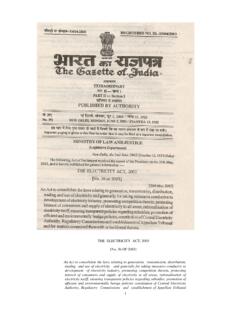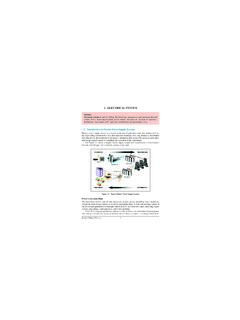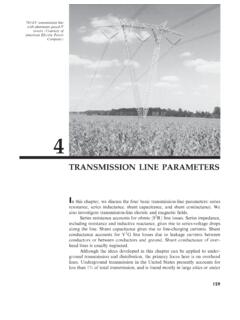Transcription of Assessing HVDC Transmission for Impacts of Non ...
1 Assessing hvdc Transmission for Impacts of Non Dispatchable Generation June 2018 Independent Statistics & Analysis Department of energy Washington, DC 20585 June 2018 energy information administration | Assessing hvdc Transmission for Impacts of Non Dispatchable Generation 1 Assessing hvdc Transmission for Impacts of Non Dispatchable Generation Given the increase in renewable generation in recent years, it has become increasingly important to understand the manner in which operational challenges arising from intermittency may be mitigated with other technologies or operating procedures.
2 One such technology is high voltage direct current ( hvdc ) Transmission lines. To help better inform the energy information administration s (EIA) long term planning models and projections, EIA commissioned a study from ICF Incorporated, LLC (ICF) to assess the role that hvdc Transmission lines may play as additional renewable generation sources become integrated into electrical grids. More specifically, ICF was asked to review the extent to which they believed hvdc lines may mitigate challenges resulting from additional renewable generation, the advantages and disadvantages of using hvdc lines to transmit the electricity generated from renewable sources, and the potential costs of constructing additional hvdc lines in a formal analysis based on many sources of information .
3 To provide some background, electricity generated by renewable resources can be categorized into two types dispatchable and non dispatchable generation. Dispatchable generation sources include conventional hydroelectric, geothermal, and biomass. Non dispatchable (or intermittent or variable) generation sources like solar and wind, however, depend on the resource availability, such as when the sun is shining or the wind is blowing. As a result, these technologies have limited capability to respond to generation dispatch signals. The increasing deployment and penetration of non dispatchable renewable generation from resources like solar and wind can lead to electrical system operational issues, which include under or over generation during times of high or low electricity demand.
4 Such conditions could potentially require additional grid services to accommodate the associated fluctuations in generation delivered from these resources. Power Transmission lines facilitate the bulk transfer of electricity from a generating station to a local distribution network. The electric Transmission network consists of around 700,000 circuit miles of lines. Most of these lines operate with alternating current, which is how power is typically generated and delivered to the end use customers. hvdc lines have typically been used to transfer large amounts of power over long distances.
5 They are now being proposed as a way to move electricity generated from wind in high quality wind resource regions to other parts of the country. If properly configured, direct current Transmission could also help mitigate operational issues with wind and solar generation such as a mismatch in generation in relation to the need for increased ancillary services associated with renewable generation. This can be accomplished by effectively moving electricity generated from wind or solar resources from areas of high penetration to areas with lower penetration.
6 It should be noted that challenges associated with increased penetration of generation from wind and solar resources may also be mitigated using a variety of other technologies or practices, including smart grid technologies, energy storage, or other flexible generating technologies. However, the role that hvdc lines may play in mitigating some of the potential challenges imposed by the growth in non dispatchable renewable generation on electric grids is an important consideration. June 2018 energy information administration | Assessing hvdc Transmission for Impacts of Non Dispatchable Generation 2 APPENDIX Assessment of the Potential for high voltage Direct Current Transmission to Mitigate Impacts of Non Dispatchable Generation Technologies FINAL REPORT March 2018 Submitted to: United States energy information administration (EIA) Washington, DC Submitted by: ICF Incorporated, LLC Fairfax, VA i Table of Contents List of Figures.
7 Ii List of Tables .. ii List of Abbreviations, Acronyms, and Initialisms .. iii 1. Summary of Findings .. 1 2. Introduction and Background .. 3 Objectives of Report .. 3 Review of questions to be answered .. 3 Discussion of approach .. 4 Report 4 Overview of hvdc Technology .. 4 History of hvdc technology .. 4 Modern hvdc lines deployment trends .. 5 hvdc deployment in the United States .. 6 Technical features of hvdc technology .. 7 Advantages and disadvantages of hvdc Transmission technology .. 9 3. Analysis and Results.
8 13 Role of hvdc in Mitigating Non Dispatchable Generation Impacts .. 13 impact of large scale non dispatchable generation on system operation .. 13 Potential hvdc solutions application .. 15 Summary and Insights on Costs from hvdc Project Case Studies .. 17 Cost Trends in hvdc Lines/Technologies in the United States .. 23 Cost Estimates from specific case studies of hvdc projects (publicly available) .. 23 Summary and insights on hvdc cost trends .. 25 4. Conclusions .. 28 5. References .. 29 Appendices .. A 1 Case Studies of Potential Implementation of hvdc Solutions.
9 A 1 TransWest Express Project in A 1 MISO Conceptual hvdc Network Case A 6 SPP s Clean line Project Case Study .. A 11 Literature Survey on Applicability of hvdc for Renewable Integration .. A 18 Literature Review on hvdc Project Costs .. A 27 List of Existing and Proposed hvdc Projects in the United States .. A 30 Glossary .. A 32 ii List of Figures Figure 1. Existing and planned hvdc lines and interties in North America .. 7 Figure 2. Schematic of an hvdc line .. 9 Figure 3. Comparison of hvdc to HVAC lines (losses and typical configuration).
10 10 Figure 4. Cost comparison curves for hvdc and AC lines (generic estimates) .. 12 Figure 5. Generation capacity in the United States by fuel type (existing and planned) .. 14 Figure 6. Wind and solar generation capacity in the United States (existing and planned).. 14 Figure 7. Net generation trends in the United States (by fuel type) .. 15 Figure 8. Installed capacity trends for CAISO (existing and planned) .. A 1 Figure 9. Recent net generation trends in California (GWh) .. A 2 Figure 10. Proposed TransWest project in Western Interconnect.
